Communication is a process whereby information is enclosed in a package and is channeled and imparted by a sender to a receiver via some medium. The receiver then decodes the message and gives the sender a feedback. All forms of communication require a sender, a message, and an intended recipient, however the receiver need not be present or aware of the sender's intent to communicate at the time of communication in order for the act of communication to occur. Communication requires that all parties have an area of communicative commonality. There are auditory means, such as speech, song, and tone of voice, and there are nonverbal means, such as body language, sign language, paralanguage, touch, eye contact, through media, i.e., pictures, graphics and sound, and writing.
A business (also known as company, enterprise, or firm) is a legally recognized organization designed to provide goods, services, or both to consumers or tertiary business in exchange for money.Businesses are predominant in capitalist economies, in which most businesses are privately owned and typically formed to earn profit that will increase the wealth of its owners.
Jadi komunikasi bisnis adalah komunikasi yang digunakan dalam dunia bisnis yang mencakup berbagai macam jenis dan bentuk komunikasi untuk mencapai tujuan bisnis dan karena Komunikasi bisnis ini merupakan komunikasi yang terjadi di dunia bisnis, jadi kita tidak boleh melanggar norma-norma yang ditetapkan oleh dunia bisnis ketika melakukan komunikasi. So business communication is communication that is used in the business world that includes various types and forms of communication to achieve business objectives and because this business communication is communication that occurs in the business world, so we must not violate the norms set by the business world while performing communication. Biasanya komunikasi bisnis memiliki aturan yang ketat, keras, formal, terstatndar dan tanpa toleransi. Usually, business communication has strict rules, hard, formal, standart and intolerant.
1. Please explain briefly the part of the letter !
1. THE HEADING
The heading of a letter contains the street address, city, state, and the date.
2. THE INSIDE ADDRESS
In social correspondence what is known as the inside address is omitted .In correspondence it is obviously necessary. The name andaddress of the person to whom a business letter is sent is placed at the left-hand side of the letter sheet below the heading,
3. THE SALUTATION
The salutation, or complimentary address to the person to whom the letter is written, in a social letter should begin at the left-hand side of the sheet about half an inch below the heading and an inch from the edge of the paper.
4. THE BODY OF THE LETTER
In the placing of a formal note it must be arranged so that the complete note appears on the first page only. The social letter is either formal or informal. The formal letter must be written according to certain established practice. It is the letter used for invitations to formal affairs, for announcements, and for the acknowledgment of these letters. The third person must always be used. If one receives a letter written in the third person one must answer in kind. It would be obviously incongruous to write. For the informal letter there are no set rules except that of courtesy, which requires that we have our thought distinctly in mind before putting it on paper. It may be necessary to pause a few moments before writing, to think out just what we want to say. A rambling, incoherent letter is not in good taste any more than careless, disheveled clothing. Spelling should be correct. If there is any difficulty in spelling, a small dictionary kept in the desk drawer is easily consulted. Begin each sentence with a capital. Start a new paragraph when you change to a new subject. Put periods (or interrogation points as required) at the ends of the sentences. It is neater to preserve a margin on both sides of the letter sheet. In the body of a business letter the opening sentence is in an important position, and this is obviously the place for an important fact. It ought in some way to state or refer to the subject of or reason for the letter, so as to get the attention of the reader immediately to the subject.
5. THE COMPLIMENTARY CLOSE
The complimentary close follows the body of the letter, about two or three spaces below it. It begins about in the center of the page under the body of the letter. Only the first word should be capitalized and a comma is placed at the end. The wording may vary according to the degree of cordiality or friendship
6. THE SIGNATURE
The signature is written below the complimentary close and a little to the right, so that it ends about at the right-hand margin
7. THE SUPERSCRIPTION
In the outside address or superscription of a letter the following forms.
3. Please find out the style of letter !
Block
In a Block format letter, (1) all text is aligned to the left margin, (2) paragraphs are not indented. 3) parts and paragraphs are separated by double or triple spacing.
Semi-Block
In a Semi-Block format letter, (1) all text is aligned to the left margin, (2) paragraphs are indented.
Modified Block
In a Modified Block format letter, (1) all text is aligned to the left margin, except for the author's address, date, and closing; and (2) paragraphs are not indented. The author's address, date, and closing are usually indented three inches from the left margin, but can be set anywhere to the right of the middle of the page, as long as all three elements are indented to the same position.
Modified Semi-Block
In a Modified Semi-Block format letter, (1) all text is aligned to the left margin, except for the author's address, date, and closing; and (2) paragraphs are indented. The author's address, date, and closing are usually indented three inches from the left margin, but can be set anywhere to the right of the middle of the page, as long as all three elements are indented to the same position.
1. Semiblock
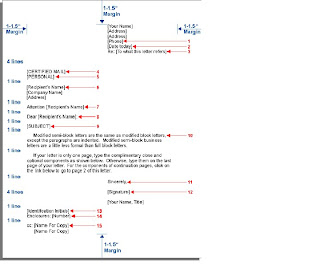
Legend:
1. Return Address: If your stationery has a letterhead, skip this. Otherwise, type your name, address and optionally, phone number, five spaces to the right of center or flush with the right margin. Five spaces to the right of center is common. These days, it's also common to include an email address.
2. Date: Type the date five spaces to the right of center or flush with the right margin, two to six lines below the letterhead. Five spaces to the right of center and three lines below the letterhead are common. If there is no letterhead, type it where shown.
3. Reference Line: If the recipient specifically requests information, such as a job reference or invoice number, type it on one or two lines, immediately below and aligned with the Date (2). If you're replying to a letter, refer to it here. For example,
• Re: Job # 625-01
• Re: Your letter dated 1/1/200x.
4. Special Mailing Notations: Type in all uppercase characters, if appropriate. Examples include
• SPECIAL DELIVERY
• CERTIFIED MAIL
• AIRMAIL
5. On-Arrival Notations: Type in all uppercase characters, if appropriate. You might want to include a notation on private correspondence, such as a resignation letter. Include the same on the envelope. Examples are
• PERSONAL
• CONFIDENTIAL
6. Inside Address: Type the name and address of the person and/or company to whom you're sending the letter, three to eight lines below the last component you typed. Four lines are standard. If you type an Attention Line (7), skip the person's name here. Do the same on the envelope.
7. Attention Line: Type the name of the person to whom you're sending the letter. If you type the person's name in the Inside Address (6), skip this. Do the same on the envelope.
8. Salutation: Type the recipient's name here. Type Mr. or Ms. [Last Name] to show respect, but don't guess spelling or gender. Some common salutations are
• Ladies:
• Gentlemen:
• Dear Sir:
• Dear Sir or Madam:
• Dear [Full Name]:
• To Whom it May Concern:
9. Subject Line: Type the gist of your letter in all uppercase characters. Be concise on one line. If you type a Reference Line (3), consider if you really need this line. While it's not really necessary for most employment-related letters, examples are below.
• SUBJECT: RESIGNATION
• LETTER OF REFERENCE
• JOB INQUIRY
10. Body: Indent the first sentence in paragraphs five spaces. Type two spaces between sentences. Keep it brief and to the point.
11. Complimentary Close: Type this aligned with the Date (2). What you type here depends on the tone and degree of formality. For example,
• Respectfully yours (very formal)
• Sincerely (typical, less formal)
• Very truly yours (polite, neutral)
• Cordially yours (friendly, informal)
12. Signature Block: Align this block with the Complimentary Close (11). Leave four blank lines to sign your name. Sign it exactly the same as you typed it below your signature. Title is optional depending on relevancy and degree of formality. Examples are
• John Doe, Manager
• P. Smith
Director, Technical Support
• R. T. Jones - Sr. Field Engineer
13. Identification Initials: If someone typed the letter for you, he or she would typically include three of your initials in all uppercase characters, then two of his or hers in all lowercase characters. If you typed your own letter, just skip it since your name is already in the Signature Block (12). Common styles are below.
• JAD/cm
• JAD:cm
• clm
14. Enclosure Notation: This line tells the reader to look in the envelope for more. Type the singular for only one enclosure, plural for more. If you don't enclose anything, skip it. Common styles are below.
• Enclosure
• Enclosures: 3
• Enclosures (3)
15. cc: Stands for courtesy copies (formerly carbon copies). List the names of people to whom you distribute copies, in alphabetical order. If addresses would be useful to the recipient of the letter, include them. If you don't copy your letter to anyone, skip it.
2. Profesinoal
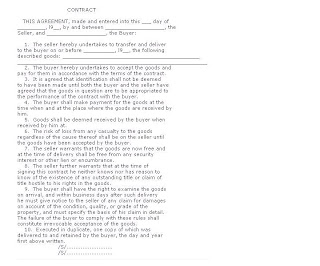
3. Block Style
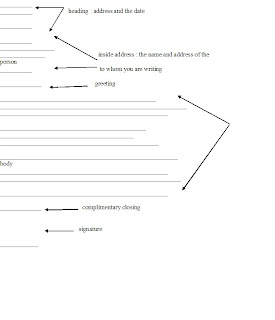
4. Full Block
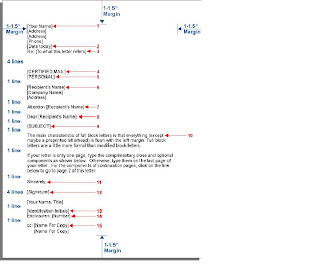
Legend:
1. Return Address: If your stationery has a letterhead, skip this. Otherwise, type your name, address and optionally, phone number. These days, it's common to also include an email address.
2. Date: Type the date of your letter two to six lines below the letterhead. Three are standard. If there is no letterhead, type it where shown.
3. Reference Line: If the recipient specifically requests information, such as a job reference or invoice number, type it on one or two lines, immediately below the Date (2). If you're replying to a letter, refer to it here. For example,
• Re: Job # 625-01
• Re: Your letter dated 1/1/200x.
4. Special Mailing Notations: Type in all uppercase characters, if appropriate. Examples include
• SPECIAL DELIVERY
• CERTIFIED MAIL
• AIRMAIL
5. On-Arrival Notations: Type in all uppercase characters, if appropriate. You might want to include a notation on private correspondence, such as a resignation letter. Include the same on the envelope. Examples are
• PERSONAL
• CONFIDENTIAL
6. Inside Address: Type the name and address of the person and/or company to whom you're sending the letter, three to eight lines below the last component you typed. Four lines are standard. If you type an Attention Line (7), skip the person's name here. Do the same on the envelope.
7. Attention Line: Type the name of the person to whom you're sending the letter. If you type the person's name in the Inside Address (6), skip this. Do the same on the envelope.
8. Salutation: Type the recipient's name here. Type Mr. or Ms. [Last Name] to show respect, but don't guess spelling or gender. Some common salutations are
• Ladies:
• Gentlemen:
• Dear Sir:
• Dear Sir or Madam:
• Dear [Full Name]:
• To Whom it May Concern:
9. Subject Line: Type the gist of your letter in all uppercase characters, either flush left or centered. Be concise on one line. If you type a Reference Line (3), consider if you really need this line. While it's not really necessary for most employment-related letters, examples are below.
• SUBJECT: RESIGNATION
• LETTER OF REFERENCE
• JOB INQUIRY
10. Body: Type two spaces between sentences. Keep it brief and to the point.
11. Complimentary Close: What you type here depends on the tone and degree of formality. For example,
• Respectfully yours (very formal)
• Sincerely (typical, less formal)
• Very truly yours (polite, neutral)
• Cordially yours (friendly, informal)
12. Signature Block: Leave four blank lines after the Complimentary Close (11) to sign your name. Sign your name exactly as you type it below your signature. Title is optional depending on relevancy and degree of formality. Examples are
• John Doe, Manager
• P. Smith
Director, Technical Support
• R. T. Jones - Sr. Field Engineer
13. Identification Initials: If someone typed the letter for you, he or she would typically include three of your initials in all uppercase characters, then two of his or hers in all lowercase characters. If you typed your own letter, just skip it since your name is already in the Signature Block (12). Common styles are below.
• JAD/cm
• JAD:cm
• clm
14. Enclosure Notation: This line tells the reader to look in the envelope for more. Type the singular for only one enclosure, plural for more. If you don't enclose anything, skip it. Common styles are below.
• Enclosure
• Enclosures: 3
• Enclosures (3)
15. cc: Stands for courtesy copies (formerly carbon copies). List the names of people to whom you distribute copies, in alphabetical order. If addresses would be useful to the recipient of the letter, include them. If you don't copy your letter to anyone, skip it.
5. Standart
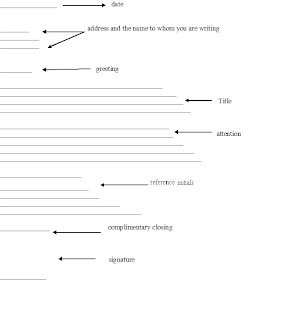
Tidak ada komentar:
Posting Komentar